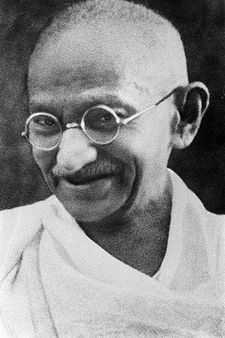
Though Mohandas Gandhi valued simplicity, he would undoubtedly be delighted that the rampant spread of technology has made Gandhian non-violence more effective. Indeed, the digital age — when every phone is a camera and a telegraph — makes Gandhism far more potent than it was when he was alive.
Truth is, Gandhi’s approach was not well suited to his time. He relied on widespread dissemination of information about atrocities through mass media at a moment when mass media reach was (relatively) limited. Suffering must be witnessed to cause moral alarm in the outside world or shame on the inside. But governments were good at brutalizing in private even back then, and they’ve only gotten better at controlling sources of information.
Gandhi’s approach was not just about the non-violent action, it was about eliciting an unjust, violent re-action – not about avoiding suffering of the people but welcoming it.
“Things of fundamental importance to people are not secured by reason alone, but have to be purchased with their suffering,” he said. “Suffering is infinitely more powerful than the law of the jungle for converting the opponent and opening his ears which are otherwise shut to the voice of reason.”
The dynamic in Iran has fit Gandhi’s understanding of human psychology. When millions peacefully protested in Iran, the government fell directly into the Gandhian trap, brutally murdering some protesters. By drawing the government into violent — and public — misbehavior, the protesters drew the state into a downward spiral in which the leaders progressively eroded their own authority through their own actions.
In Iran, the regime that started with one crisis of legitimacy (the election) now has a second one (around the killing of citizens). This will draw more to the streets, which will probably draw more violent reaction, further undercutting their standing.
It is excruciatingly difficult to maintain a non-violent posture in the face of state violence. In truth, not all the protesters have taken this approach. Throwing rocks, chanting “Death to the Dictator,” hunting basijs — these do little damage to the state but run the risk of eroding the moral authority of the protesters.
America’s practitioner of the technique, Rev. Martin Luther King, was deeply influenced by the Hindu Gandhi who was, in turn, influenced by Jesus (see this brilliant essay by King confidant and Gandhi scholar Harris Wofford) but it’s an open question whether Islam has within its traditions the spiritual foundation for a Muslim style of non-violent civil disobedience.
Significantly, Mir Hossein Moussavi, reportedly moved close to Gandhian rhetoric in cautioning Iranian protesters to resist the temptation toward violence:
“I, as a mourner, invite the people to self-restraint. The country belongs to you. The revolution and the government are your inheritances. Objecting to lies and cheating is your right.
Be hopeful in exercising your rights and do not allow those, who try to instill fear in you to dissuade you, to make you angry. Continue to avoid violence in your protests and treat the disproportionate actions of the security forces as broken hearted parents would their children.”
 The reason Neda Agha Soltan has become the symbol of injustice is not just because she’s young and a woman, it’s because she was standing passively. She becomes a martyr in a way a rock-thrower wouldn’t. Her death therefore will hurt the regime infinitely more.
The reason Neda Agha Soltan has become the symbol of injustice is not just because she’s young and a woman, it’s because she was standing passively. She becomes a martyr in a way a rock-thrower wouldn’t. Her death therefore will hurt the regime infinitely more.
That’s why the most important idea in President Obama’s statement yesterday may have been the most Gandhian: “right now, we are bearing witness to the Iranian peoples’ belief in that truth, and we will continue to bear witness.”
It is witness that gives the non-violent approach its power, by making private suffering public. The protesters will be severely tested; restraint will be nearly impossible. But if the Iranians pull it off, it will provide an inspiring epilogue to Gandhi’s story. He went to his death feeling he’d failed in part because he had been unable to convince enough Indian Muslims to embrace his approach. Nothing would make him happier than if it turned out to be millions of Muslims who gave birth to 21st century Gandhism.
Cross-posted with Wall Street Journal Online.

